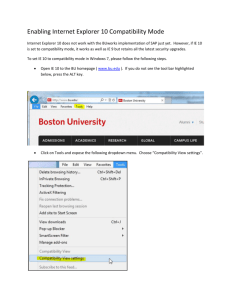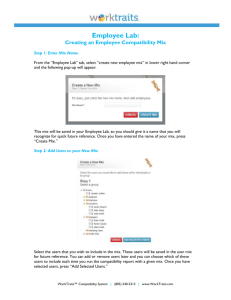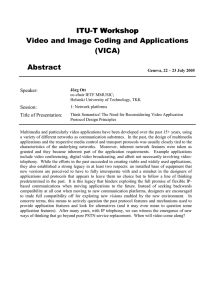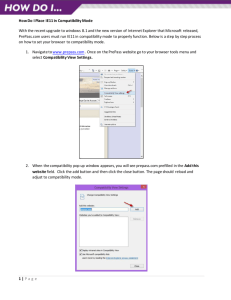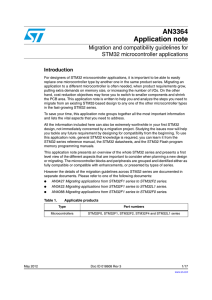TheTestEye – Software Quality Characteristics
advertisement
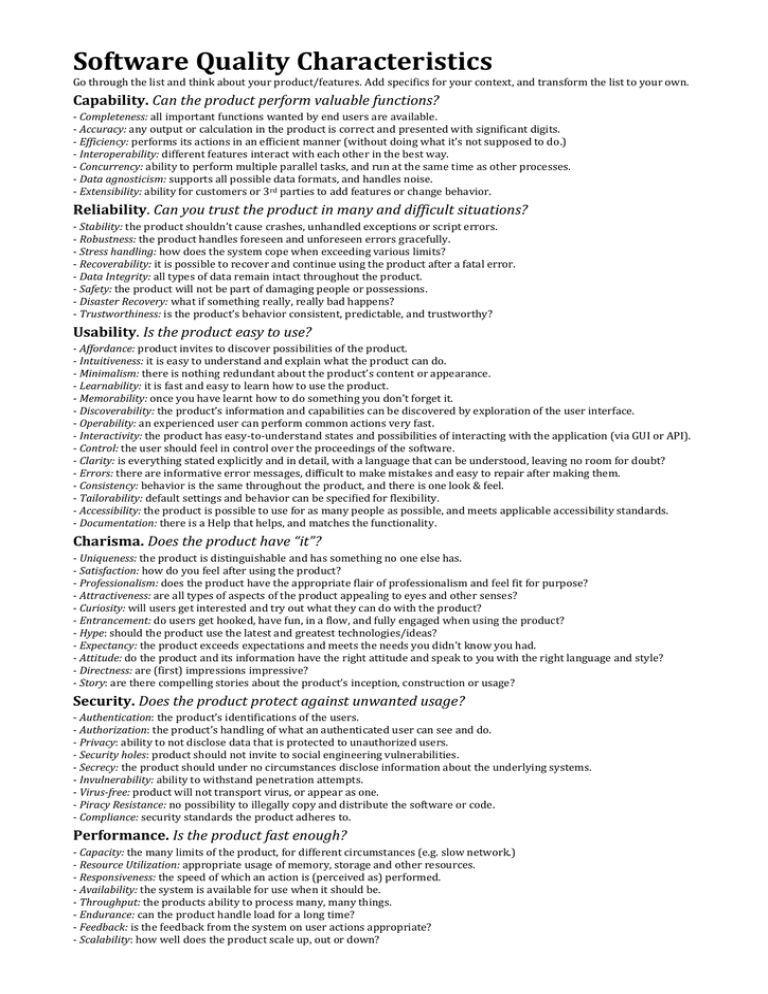
Software Quality Characteristics Go through the list and think about your product/features. Add specifics for your context, and transform the list to your own. Capability. Can the product perform valuable functions? - Completeness: all important functions wanted by end users are available. - Accuracy: any output or calculation in the product is correct and presented with significant digits. - Efficiency: performs its actions in an efficient manner (without doing what it’s not supposed to do.) - Interoperability: different features interact with each other in the best way. - Concurrency: ability to perform multiple parallel tasks, and run at the same time as other processes. - Data agnosticism: supports all possible data formats, and handles noise. - Extensibility: ability for customers or 3rd parties to add features or change behavior. Reliability. Can you trust the product in many and difficult situations? - Stability: the product shouldn’t cause crashes, unhandled exceptions or script errors. - Robustness: the product handles foreseen and unforeseen errors gracefully. - Stress handling: how does the system cope when exceeding various limits? - Recoverability: it is possible to recover and continue using the product after a fatal error. - Data Integrity: all types of data remain intact throughout the product. - Safety: the product will not be part of damaging people or possessions. - Disaster Recovery: what if something really, really bad happens? - Trustworthiness: is the product’s behavior consistent, predictable, and trustworthy? Usability. Is the product easy to use? - Affordance: product invites to discover possibilities of the product. - Intuitiveness: it is easy to understand and explain what the product can do. - Minimalism: there is nothing redundant about the product’s content or appearance. - Learnability: it is fast and easy to learn how to use the product. - Memorability: once you have learnt how to do something you don’t forget it. - Discoverability: the product’s information and capabilities can be discovered by exploration of the user interface. - Operability: an experienced user can perform common actions very fast. - Interactivity: the product has easy-to-understand states and possibilities of interacting with the application (via GUI or API). - Control: the user should feel in control over the proceedings of the software. - Clarity: is everything stated explicitly and in detail, with a language that can be understood, leaving no room for doubt? - Errors: there are informative error messages, difficult to make mistakes and easy to repair after making them. - Consistency: behavior is the same throughout the product, and there is one look & feel. - Tailorability: default settings and behavior can be specified for flexibility. - Accessibility: the product is possible to use for as many people as possible, and meets applicable accessibility standards. - Documentation: there is a Help that helps, and matches the functionality. Charisma. Does the product have “it”? - Uniqueness: the product is distinguishable and has something no one else has. - Satisfaction: how do you feel after using the product? - Professionalism: does the product have the appropriate flair of professionalism and feel fit for purpose? - Attractiveness: are all types of aspects of the product appealing to eyes and other senses? - Curiosity: will users get interested and try out what they can do with the product? - Entrancement: do users get hooked, have fun, in a flow, and fully engaged when using the product? - Hype: should the product use the latest and greatest technologies/ideas? - Expectancy: the product exceeds expectations and meets the needs you didn't know you had. - Attitude: do the product and its information have the right attitude and speak to you with the right language and style? - Directness: are (first) impressions impressive? - Story: are there compelling stories about the product’s inception, construction or usage? Security. Does the product protect against unwanted usage? - Authentication: the product’s identifications of the users. - Authorization: the product’s handling of what an authenticated user can see and do. - Privacy: ability to not disclose data that is protected to unauthorized users. - Security holes: product should not invite to social engineering vulnerabilities. - Secrecy: the product should under no circumstances disclose information about the underlying systems. - Invulnerability: ability to withstand penetration attempts. - Virus-free: product will not transport virus, or appear as one. - Piracy Resistance: no possibility to illegally copy and distribute the software or code. - Compliance: security standards the product adheres to. Performance. Is the product fast enough? - Capacity: the many limits of the product, for different circumstances (e.g. slow network.) - Resource Utilization: appropriate usage of memory, storage and other resources. - Responsiveness: the speed of which an action is (perceived as) performed. - Availability: the system is available for use when it should be. - Throughput: the products ability to process many, many things. - Endurance: can the product handle load for a long time? - Feedback: is the feedback from the system on user actions appropriate? - Scalability: how well does the product scale up, out or down? IT-bility. Is the product easy to install, maintain and support? - System requirements: ability to run on supported configurations, and handle different environments or missing components. - Installability: product can be installed on intended platforms with appropriate footprint. - Upgrades: ease of upgrading to a newer version without loss of configuration and settings. - Uninstallation: are all files (except user’s or system files) and other resources removed when uninstalling? - Configuration: can the installation be configured in various ways or places to support customer’s usage? - Deployability: product can be rolled-out by IT department to different types of (restricted) users and environments. - Maintainability: are the product and its artifacts easy to maintain and support for customers? - Testability: how effectively can the deployed product be tested by the customer? Compatibility. How well does the product interact with software and environments? - Hardware Compatibility: the product can be used with applicable configurations of hardware components. - Operating System Compatibility: the product can run on intended operating system versions, and follows typical behavior. - Application Compatibility: the product, and its data, works with other applications customers are likely to use. - Configuration Compatibility: product’s ability to blend in with configurations of the environment. - Backward Compatibility: can the product do everything the last version could? - Forward Compatibility: will the product be able to use artifacts or interfaces of future versions? - Sustainability: effects on the environment, e.g. energy efficiency, switch-offs, power-saving modes, telecommuting. - Standards Conformance: the product conforms to applicable standards, regulations, laws or ethics. Internal Software Quality Characteristics These characteristics are not directly experienced by end users, but can be equally important for successful products. Supportability. Can customers’ usage and problems be supported? - Identifiers: is it easy to identify parts of the product and their versions, or specific errors? - Diagnostics: is it possible to find out details regarding customer situations? - Troubleshootable: is it easy to pinpoint errors (e.g. log files) and get help? - Debugging: can you observe the internal states of the software when needed? - Versatility: ability to use the product in more ways than it was originally designed for. Testability. Is it easy to check and test the product? - Traceability: the product logs actions at appropriate levels and in usable format. - Controllability: ability to independently set states, objects or variables. - Observability: ability to observe things that should be tested. - Monitorability: can the product give hints on what/how it is doing? - Isolateability: ability to test a part by itself. - Stability: changes to the software are controlled, and not too frequent. - Automation: are there public or hidden programmatic interface that can be used? - Information: ability for testers to learn what needs to be learned... - Auditability: can the product and its creation be validated? Maintainability. Can the product be maintained and extended at low cost? - Flexibility: the ability to change the product as required by customers. - Extensibility: will it be easy to add features in the future? - Simplicity: the code is not more complex than needed, and does not obscure test design, execution and evaluation. - Readability: the code is adequately documented and easy to read and understand. - Transparency: Is it easy to understand the underlying structures? - Modularity: the code is split into manageable pieces. - Refactorability: are you satisfied with the unit tests? - Analyzability: ability to find causes for defects or other code of interest. Portability. Is transferring of the product to different environments enabled? - Reusability: can parts of the product be re-used elsewhere? - Adaptability: is it easy to change the product to support a different environment? - Compatibility: does the product comply with common interfaces or official standards? - Internationalization: it is easy to translate the product. - Localization: are all parts of the product adjusted to meet the needs of the targeted culture/country? - User Interface-robustness: will the product look equally good when translated? Rikard Edgren, Henrik Emilsson and Martin Jansson - thetesteye.com v1.1 This work is licensed under the Creative Commons Attribution-No Derivative License inspired by James Bach’s CRUSSPIC STMPL, ISO 9126-1, Wikipedia:Ilities and more…
